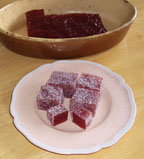
I have some lovely large quinces, from which I wish to make quince paste or pâte de coings, also known as fruit cheese, for the winter holidays. Quince paste is one of the thirteen desserts of a Provençal Christmas. From a very old book given me by a friend, NOUVELLE INSTRUCTION POUR LES CONFITURES, LES LIQUEURS, ET LES FRUITS, Chez Claude Prudhomme. Paris, MDCCXVI, I have translated the following recipe:
"Page 150, Paste of Quinces
Have large Quinces well ripe & the yellows, healthiest which you will be able. Peel them & remove the heart if you want, if not leave the whole, satisfying you to cut your Quinces by quarters. You make boil water on fire, where you throw them, & make you cook them until they feel well soft. When they are, you drain it, to put them in a colander or net [chinois]; then pass them to you by the sieve [put through a food mill]. Being passed, you give your Paste for the drying to large fire, & then incorporate it with crushed Sugar, five quarters of Sugar for Fruit pound. You make it boil, & draw up it like the Others [It is necessary then to make it boil, & also early draw up it on slates or in your moulds of tinplate, made in heart, square, flower-of-lily, & other manners, which you will put at the oven for drying.]"
I did not peel my quinces --I wanted to make sure that as much pectin was extracted from the skins as possible, but did quarter them and I removed the core. I put them to simmer with a little water in a poëlon [frying pan or ceramic French casserole] for about 30 minutes. I then poured them and their liquid into a conical food mill and saved the juice and the pulp after reaming. To this juice and pulp, I added as much white sugar by volume and returned it to the pan to cook very slowly on the lowest heat, allowing as much moisture as possible to evaporate. I stirred the mixture from time to time, and after about an hour, the mass was a dull clear red and so thick it would draw away from the sides of the pan and leave wide, clean tracks so that I could see the bottom of the pan and it did not fall back into itself. I then poured, dumped really, the whole into a buttered tian [flat ceramic baking dish] and smoothed the top of the paste with a spatula. It set up into a fine paste, much like a gumdrop, which I then cut into squares [Because they had cooked so long and were so dry or "drawn," it wasn't necessary to dry them on screens. If your pastes should be ever so slightly moist, do dry them between plastic screens to keep insects off until they are dry to the touch and not sticky.] I then rolled each cube in white sugar and put them into a waxed paper-lined box with a tight fitting cover, in order to make sure they will last until the holidays. Each bite was an intense flavor burst with fruity-floral aroma on the palette--exquisite.
Pears, apples, sloes [sadly not available in America], crab apples, japonica fruit or medlars can be processed into paste the same way. And on this delightful site, I found many ways to use the quince paste other than as a candy. Enjoy!

No comments:
Post a Comment